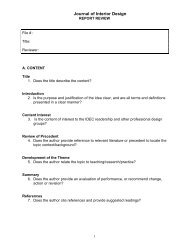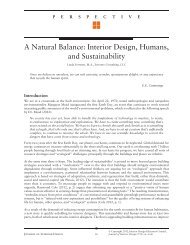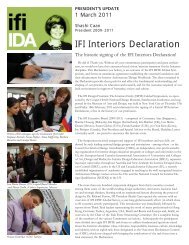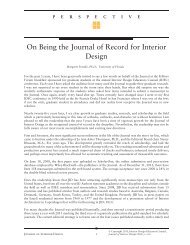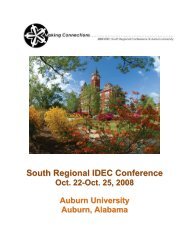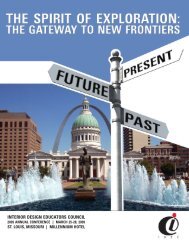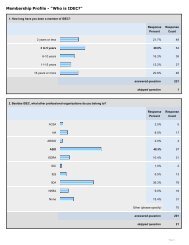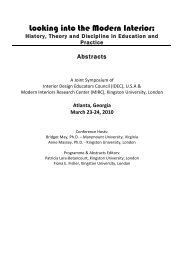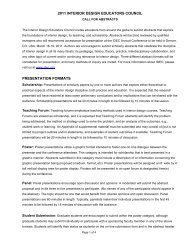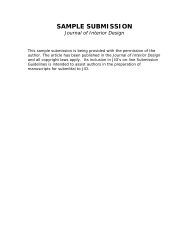2002 Conference Proceedings - Interior Design Educators Council
2002 Conference Proceedings - Interior Design Educators Council
2002 Conference Proceedings - Interior Design Educators Council
You also want an ePaper? Increase the reach of your titles
YUMPU automatically turns print PDFs into web optimized ePapers that Google loves.
The Effects of Physical Environment on Engineering TeamPerformance: A Case StudyPaper byDaniel C. BeertSchool of <strong>Interior</strong> <strong>Design</strong> at University of KentuckyEric Grulke, Ph.D.Department of Chemical and Materials EngineeringDerek Lane, Ph.D.College of Communication,University of KentuckyPurposeIn order that interior design and engineering curriculums effectively implement requiredstudent teamwork experiences (EAC, 1998; FIDER, 2000), dramatic changes must bemade to legacy classrooms that continue to reflect more traditional learning modes.Rather than fostering collaborative activities that build communities of knowledge(Cuseo, 1996; Wenger, 1998), dis-located resources segment time, interrupt theprocessing of information, and discourage students from working together on shortdurationtasks. Instead, students rely on individual processing, where everyone works inisolation and the product is “assembled” at the end of the project (Goodwin & Wolter1998; Katzenbach & Smith 1999; Slavin, 1992).“Becoming a team is a process, not an event. Unless instructors facilitate thetransformation of groups into teams, their success in using small groups is likely to belimited at best” (Michaelson, 1994, p. 2). To facilitate effective group communication,teams must also have an awareness of the constraints imposed by the physicalenvironment. Besides adequate preparation and understanding of learning objectives,teams also need ways to control interruptions, settings that collocate team activities withtools and resources, and the ability to manipulate their physical environment to maintaincohesive communication (Covi, Olson, Rocco, Miller and Allie 1998; Michaelson, Jones,and Watson, 1993; Sundstrom & Altman, 1989).MethodologyThis case study – a multidisciplinary collaboration of interior design, engineering, andteam communication researchers – identified contextual elements and conditions ofteam-learning environments, including a clearer picture of spaces typically available tostudent teams, how these spaces might be improved, and how well students understandthe role physical environment plays in team activities. In addition, the results indicatethat the ability of students to work effectively and efficiently in groups is partiallydetermined by the quality of their learning environment.39





